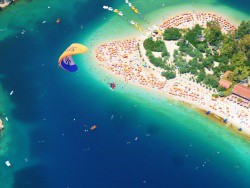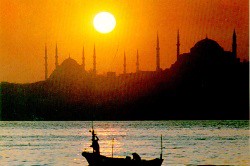 The Turkish Air Force (Turkish: Türk Hava Kuvvetleri) is a branch of the Turkish Armed Forces. It is one of the oldest air forces in the world, and with a current inventory of more than 930 aircraft, ranks 3rd in NATO in terms of fleet size, behind the USAF and RAF. Supported by long-range in-flight refueling capability, the fighter jets of the Turkish Air Force can participate in international operations and exercises on all continents of the world. READ MORE
The Turkish Air Force (Turkish: Türk Hava Kuvvetleri) is a branch of the Turkish Armed Forces. It is one of the oldest air forces in the world, and with a current inventory of more than 930 aircraft, ranks 3rd in NATO in terms of fleet size, behind the USAF and RAF. Supported by long-range in-flight refueling capability, the fighter jets of the Turkish Air Force can participate in international operations and exercises on all continents of the world. READ MORE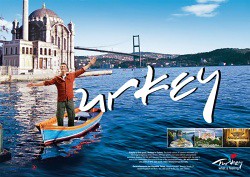
Turkey (Turkish: Türkiye), known officially as the Republic of Turkey (About this sound Türkiye Cumhuriyeti (help·info)), is a Eurasian country situated in the Anatolian peninsula, located in Western Asia, and Eastern Thrace, located in southeastern Europe. Turkey is bordered by eight countries: Bulgaria to the northwest; Greece to the west; Georgia to the northeast; Armenia, Azerbaijan (the exclave of Nakhchivan) and Iran to the east; and Iraq and Syria to the southeast. The Mediterranean Sea and Cyprus are to the south; the Aegean Sea to the west; and the Black Sea is to the north. The Sea of Marmara, the Bosphorus and the Dardanelles (which together form the Turkish Straits) demarcate the boundary between Eastern Thrace and Anatolia; they also separate Europe and Asia.
MORE

Turkey (Turkish: Türkiye), known officially as the Republic of Turkey (About this sound Türkiye Cumhuriyeti (help·info)), is a Eurasian country situated in the Anatolian peninsula, located in Western Asia, and Eastern Thrace, located in southeastern Europe. Turkey is bordered by eight countries: Bulgaria to the northwest; Greece to the west; Georgia to the northeast; Armenia, Azerbaijan (the exclave of Nakhchivan) and Iran to the east; and Iraq and Syria to the southeast. The Mediterranean Sea and Cyprus are to the south; the Aegean Sea to the west; and the Black Sea is to the north. The Sea of Marmara, the Bosphorus and the Dardanelles (which together form the Turkish Straits) demarcate the boundary between Eastern Thrace and Anatolia; they also separate Europe and Asia.

Side (Greek: Σίδη Side, Turkish: Side) was an ancient Greek city in Anatolia, in the region of Pamphylia, in what is now Antalya province, on the southern Mediterranean coast of Turkey. It is now a resort town and one of the best-known classical sites in Turkey, near the villages of Manavgat and Selimiye, 75 km from Antalya) in the province of Antalya.[1]
It is located on the eastern part of the Pamphylian coast, which lies about 20 km east of the mouth of the Eurymedon River. Today, as in antiquity, the ancient city is situated on a small north-south peninsula about 1 km long and 400 m across.
MORE

Pamukkale, meaning "cotton castle" in Turkish, is a natural site in Denizli Province in south-western Turkey. The city contains hot springs and travertines, terraces of carbonate minerals left by the flowing water. It is located in Turkey's Inner Aegean region, in the River Menderes valley, which has a temperate climate for most of the year.
The ancient city of Hierapolis was built on top of the white "castle" which is in total about 2,700 metres (8,860 ft) long, 600 m (1,970 ft) wide and 160 m (525 ft) high. It can be seen from the hills on the opposite side of the valley in the town of Denizli, 20 km away.
Tourism is and has been a major industry. People have bathed in its pools for thousands of years. As recently as the mid 20th century, hotels were built over the ruins of Heropolis, causing considerable damage. An approach road was built from the valley over the terraces, and motor bikes were allowed to go up and down the slopes. When the area was declared a world heritage site, the hotels were demolished and the road removed and replaced with artificial pools. Wearing shoes in the water is prohibited to protect the deposits.
MORE
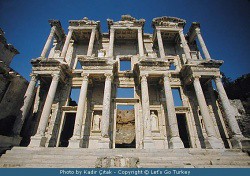
Ephesus (Ancient Greek Ἔφεσος, Turkish Efes) was an ancient Greek city, and later a major Roman city, on the west coast of Asia Minor, near present-day Selçuk, Izmir Province, Turkey. It was one of the twelve cities of the Ionian League during the Classical Greek era. In the Roman period, it was for many years the second largest city of the Roman Empire; ranking behind Rome, the empire's capital.[1][2] Ephesus had a population of more than 250,000 in the 1st century BC, which also made it the second largest city in the world.[2]
The city was famed for the Temple of Artemis (completed around 550 BC), one of the Seven Wonders of the Ancient World. The temple was destroyed in 401 AD by a mob led by St. John Chrysostom.[3] Emperor Constantine I rebuilt much of the city and erected new public baths. The town was again partially destroyed by an earthquake in 614 AD. The city's importance as a commercial center declined as the harbor was slowly silted up by the Cayster River (Küçük Menderes).
Ephesus was one of the seven churches of Asia that are cited in the Book of Revelation.[4] The Gospel of John may have been written here.[5] It is also the site of a large gladiators' graveyard.
Today's archaeological site lies 3 kilometers southwest of the town of Selçuk, in the Selçuk district of İzmir Province, Turkey. The ruins of Ephesus are a favorite international and local tourist attraction, partly owing to their easy access from Adnan Menderes Airport and via the port of Kuşadası.
MORE
Hierapolis (Greek: Ἱεράπολις 'holy city') was the ancient Greek city on top of hot springs located in south western Turkey near Denizli.
Hierapolis is a UNESCO World Heritage Site. The hot springs there have been used as a spa since the 2nd century BCE, and people came to soothe their ailments, with many of them retiring or dying here. The large necropolis is filled with sarcophagi, including the Sarcophagus of Marcus Aurelius Ammianos.
The great baths were constructed with huge stone blocks without the use of cement, and consisted of various closed or open sections linked together. There are deep niches in the inner section of the bath, library, gymnasium and other closed or open locations. The complex, which was constructed in the 2nd century BCE, constitutes a good example of vault type architecture. The complex is now an archaeological museum.
MORE
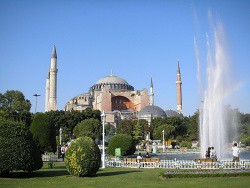
Hagia Sophia (from the Greek: Ἁγία Σοφία, "Holy Wisdom"; Latin: Sancta Sophia or Sancta Sapientia) is a former Orthodox patriarchal basilica, later a mosque and now a museum in Istanbul, Turkey. From the date of its dedication in 360 until 1453, it served as the cathedral of Constantinople, except between 1204 and 1261, when it was the cathedral of the Latin empire. The building was a mosque from 29 May 1453 until 1934, when it was secularized. It was opened as a museum on 1 February 1935.[1]
Famous in particular for its massive dome, it is considered the epitome of Byzantine architecture and is said to have "changed the history of architecture."[2] It was the largest cathedral in the world for nearly a thousand years, until Seville Cathedral was completed in 1520. The current building was originally constructed as a church between 532 and 537 on the orders of the Byzantine Emperor Justinian and was the third Church of the Holy Wisdom to occupy the site, the previous two having both been destroyed by rioters. It was designed by Isidore of Miletus, a physicist, and Anthemius of Tralles, a mathematician.[3]
The church contained a large collection of holy relics and featured, among other things, a 49 feet (15 m) silver iconostasis. It was the seat of the Patriarch of Constantinople and the religious focal point of the Eastern Orthodox Church for nearly one thousand years. It was the church in which Cardinal Humbert in 1054 marched up to the altar and excommunicated Michael I Cerularius, which is commonly considered the start of the Great Schism.
In 1453, Constantinople was conquered by the Ottoman Turks and Sultan Mehmed II ordered the building to be converted into a mosque.[4] The bells, altar, iconostasis, and sacrificial vessels were removed and many of the mosaics were eventually plastered over. The Islamic features — such as the mihrab, the minbar, and the four minarets outside — were added over the course of its history under the Ottomans. It remained as a mosque until 1935, when it was converted into a museum by the Republic of Turkey.
For almost 500 years the principal mosque of Istanbul, Hagia Sophia served as a model for many other Ottoman mosques, such as the Sultan Ahmed Mosque (Blue Mosque of Istanbul), the Şehzade Mosque, the Süleymaniye Mosque, the Rüstem Pasha Mosque and the Kılıç Ali Paşa Mosque.
Although it is sometimes referred to as Sancta Sophia, as though it were named after a saint named Sophia (sophia being the phonetic spelling in Latin of the Greek word for wisdom), the full name in Greek is Ναός τῆς Ἁγίας τοῦ Θεοῦ Σοφίας, Church of the Holy Wisdom of God, the church being dedicated to Jesus Christ, in Eastern Orthodox theology, the Holy Wisdom of God.
MORE
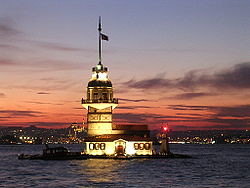
The Maiden's Tower (Turkish: Kız Kulesi), also known in the ancient Greek and medieval Byzantine periods as Leander's Tower (Tower of Leandros), sits on a small islet located in the Bosphorus strait off the coast of Üsküdar in Istanbul, Turkey.
MORE

The Topkapı Palace (Turkish: Topkapı Sarayı)[1] or in Ottoman Turkish: طوپقپو سرايى, usually spelled "Topkapi" in English) is a palace in Istanbul, Turkey, which was the official and primary residence in the city of the Ottoman Sultans for 400 years of their 624-year reign,[2] from 1465 to 1856.
The palace was a setting for state occasions and royal entertainments and is a major tourist attraction today, containing the most holy relics of the Muslim world such as the prophet Muhammed's cloak and sword.[2] Topkapı Palace is among those monuments belonging to the "Historic Areas of Istanbul", which became a UNESCO World Heritage Site in 1985, and is described in Criterion iv as "the best example[s] of ensembles of palaces [...] of the Ottoman period."[3]
Initial construction began in 1459, ordered by Sultan Mehmed II, the conqueror of Byzantine Constantinople. The palace is a complex made up of four main courtyards and many smaller buildings. At the height of its existence as a royal residence, the palace was home to as many as 4,000 people,[2] formerly covering a larger area with a long shoreline. The complex has been expanded over the centuries, with many renovations such as after the 1509 earthquake and 1665 fire. It held mosques, a hospital, bakeries, and a mint.[2] The name directly translates as "Cannon gate Palace", from the palace being named after a nearby, now destroyed, gate.
Topkapı Palace gradually lost its importance at the end of the 17th century, as the Sultans preferred to spend more time in their new palaces along the Bosporus. In 1856, Sultan Abdül Mecid I decided to move the court to the newly built Dolmabahçe Palace, the first European-style palace in the city. Some functions, such as the imperial treasury, the library, mosque and mint, were retained though.
After the end of the Ottoman Empire in 1921, Topkapı Palace was transformed by government decree on April 3, 1924 into a museum of the imperial era. The Topkapı Palace Museum is under the administration of the Ministry of Culture and Tourism. The palace complex has hundreds of rooms and chambers, but only the most important are accessible to the public today. The complex is guarded by officials of the ministry as well as armed guards of the Turkish military. The palace is full of examples of Ottoman architecture and also contains large collections of porcelain, robes, weapons, shields, armor, Ottoman miniatures, Islamic calligraphic manuscripts and murals, as well as a display of Ottoman treasure and jewelry.
MORE

Istanbul (Turkish: İstanbul, historically known as Byzantium and Constantinople;[4] see the names of Istanbul) is the largest city in Turkey and fourth largest city proper in the world with a population of 12.8 million, also making it the second largest metropolitan area in Europe by population, and the largest metropolitan city proper.[1] Istanbul is also a megacity, as well as the cultural, economic, and financial centre of Turkey. The city covers 39 districts of the Istanbul province.[5] It is located on the Bosphorus Strait and encompasses the natural harbour known as the Golden Horn, in the northwest of the country. It extends both on the European (Thrace) and on the Asian (Anatolia) sides of the Bosphorus, and is thereby the only metropolis in the world that is situated on two continents.
In its long history, Istanbul has served as the capital city of the Roman Empire (330–395), the Eastern Roman (Byzantine) Empire (395–1204 and 1261–1453), the Latin Empire (1204–1261), and the Ottoman Empire (1453–1922). The city was chosen as joint European Capital of Culture for 2010. Historic areas of Istanbul were added to the UNESCO World Heritage List in 1985
MORE
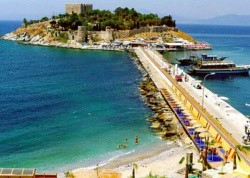
Kuşadası is a resort town on Turkey's Aegean coast[1] and the center of the seaside district of the same name in Aydın Province. Kuşadası lies at a distance of 95 km (59 mi) to the south from the region's largest metropolitan center of İzmir, and 71 km (44 mi) from the provincial seat of Aydın situated inland. Its primary industry is tourism. Her neighbours are Germencik district from northeast, Söke one from southeast, Aegean Sea from west and Selçuk district from north.
MORE
Recent Comments
Copyright © B Tube Template.






